功能整合
除了 LlmChatView 自動提供的功能之外, 還有多個整合點可讓您的應用程式 與其他功能無縫結合,以提供更多元的功能:
- 歡迎訊息:顯示給使用者的初始問候語。
- 建議提示:為使用者提供預設提示,引導互動方向。
- 系統指令:提供特定輸入給大型語言模型 (LLM),以影響其回應。
- 停用附件與語音輸入:移除聊天 UI 的選用部分。
- 管理取消或錯誤行為:變更使用者取消或 LLM 發生錯誤時的行為。
- 管理歷史紀錄:每個 LLM 提供者都支援管理聊天歷史紀錄, 這對於清除、動態變更及跨會話儲存都很實用。
- 聊天序列化/反序列化:在應用程式會話之間儲存與讀取對話內容。
- 自訂回應元件 (Widgets):引入專屬的 UI 元件來呈現 LLM 回應。
- 自訂樣式:定義獨特的視覺風格,讓聊天外觀與整體應用程式一致。
- 無 UI 聊天:可直接與 LLM 提供者互動,而不影響使用者目前的聊天會話。
- 自訂 LLM 提供者:建立您自己的 LLM 提供者,將聊天整合至自有模型後端。
- 重新導向提示:除錯、記錄或動態重新導向發送給提供者的訊息,以追蹤問題或調整提示路徑。
歡迎訊息
#聊天畫面允許您自訂歡迎訊息, 以便為使用者設定情境:
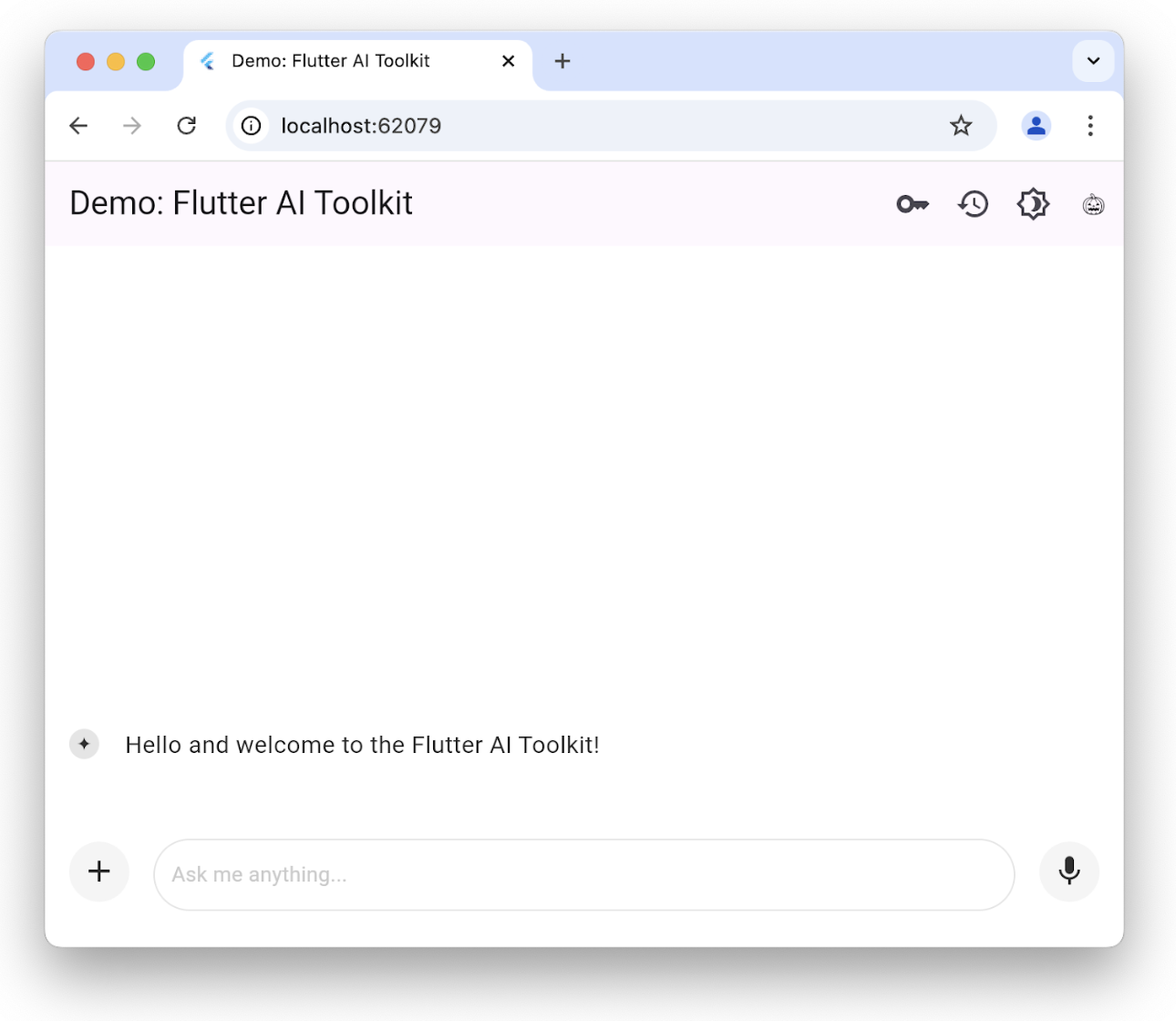
您可以透過設定 welcomeMessage 參數, 在初始化 LlmChatView 時加入歡迎訊息:
class ChatPage extends StatelessWidget {
const ChatPage({super.key});
@override
Widget build(BuildContext context) => Scaffold(
appBar: AppBar(title: const Text(App.title)),
body: LlmChatView(
welcomeMessage: 'Hello and welcome to the Flutter AI Toolkit!',
provider: GeminiProvider(
model: GenerativeModel(
model: 'gemini-2.0-flash',
apiKey: geminiApiKey,
),
),
),
);
}若要查看設定歡迎訊息的完整範例,請參考 welcome example。
建議提示語
#你可以提供一組建議提示語,讓使用者了解這個聊天會話已針對哪些情境進行最佳化:
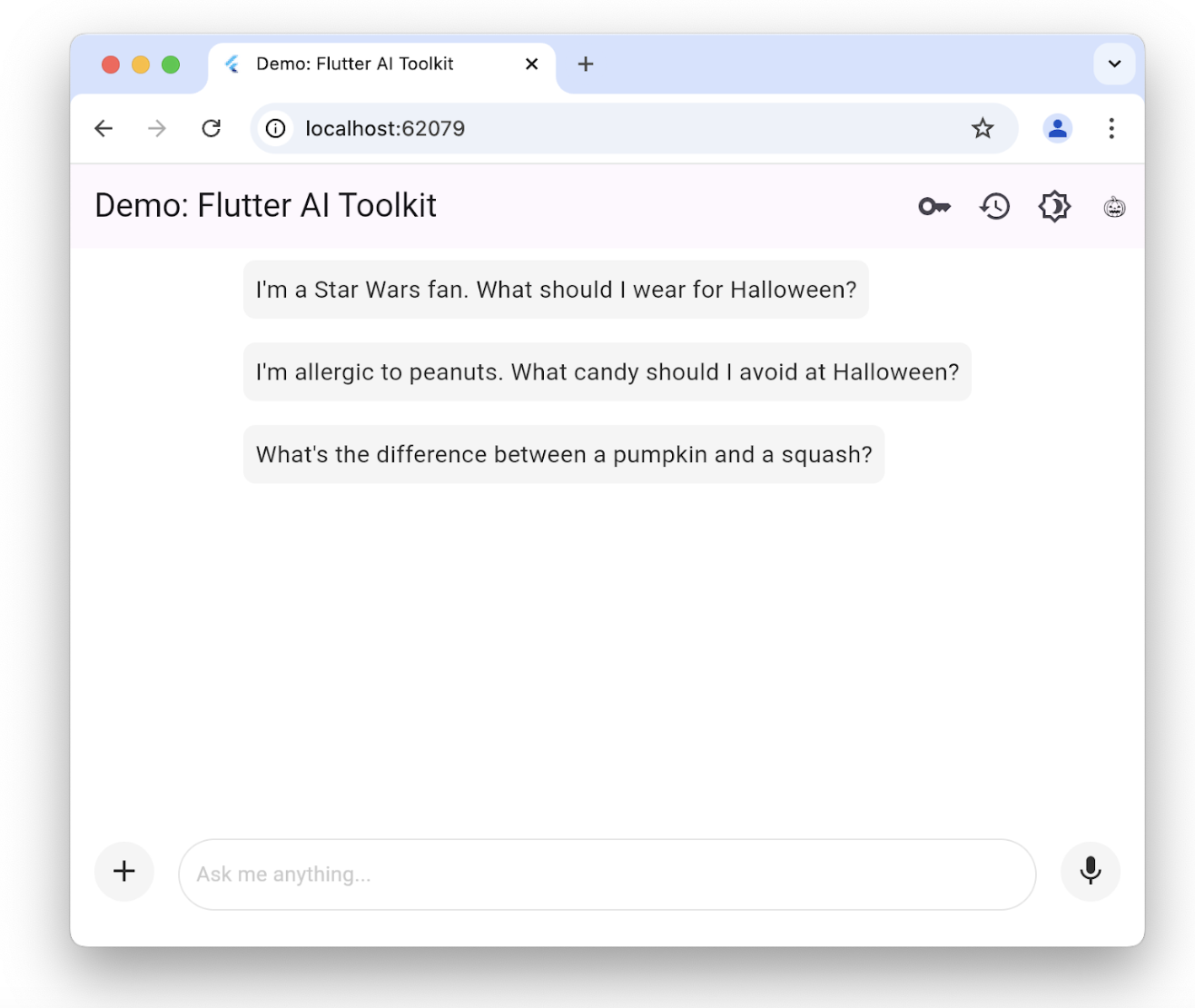
這些建議僅會在沒有現有聊天記錄時顯示。點擊其中一個建議,會將該文字複製到使用者的提示編輯區。若要設定建議清單,請使用 suggestions 參數來建構 LlmChatView:
class ChatPage extends StatelessWidget {
const ChatPage({super.key});
@override
Widget build(BuildContext context) => Scaffold(
appBar: AppBar(title: const Text(App.title)),
body: LlmChatView(
suggestions: [
'I\'m a Star Wars fan. What should I wear for Halloween?',
'I\'m allergic to peanuts. What candy should I avoid at Halloween?',
'What\'s the difference between a pumpkin and a squash?',
],
provider: GeminiProvider(
model: GenerativeModel(
model: 'gemini-2.0-flash',
apiKey: geminiApiKey,
),
),
),
);
}若要查看為使用者設定建議(suggestions)的完整範例,請參考 suggestions example。
大型語言模型 (LLM) 指令
#為了根據您的應用程式需求最佳化大型語言模型 (LLM) 的回應,您需要提供相關指令。例如,recipes example app 會使用 GenerativeModel 類別中的 systemInstructions 參數,來調整 LLM,讓其根據使用者的指示專注於提供食譜內容:
class _HomePageState extends State<HomePage> {
...
// create a new provider with the given history and the current settings
LlmProvider _createProvider([List<ChatMessage>? history]) => GeminiProvider(
history: history,
...,
model: GenerativeModel(
model: 'gemini-2.0-flash',
apiKey: geminiApiKey,
...,
systemInstruction: Content.system('''
You are a helpful assistant that generates recipes based on the ingredients and
instructions provided as well as my food preferences, which are as follows:
${Settings.foodPreferences.isEmpty ? 'I don\'t have any food preferences' : Settings.foodPreferences}
You should keep things casual and friendly. You may generate multiple recipes in a single response, but only if asked. ...
''',
),
),
);
...
}設定系統指令(system instructions)在每個提供者(provider)中都是獨特的; GeminiProvider 和 VertexProvider 都允許你透過 systemInstruction 參數來提供這些指令。
請注意,在這個例子中,我們將使用者偏好(user preferences) 納入傳遞給 LlmChatView 建構子的 大型語言模型 (LLM) 提供者的建立過程中。每當使用者變更偏好時, 我們都會在建立過程中設定指令。 食譜應用程式(recipes app)允許使用者透過 scaffold 上的抽屜(drawer) 來變更他們的飲食偏好:
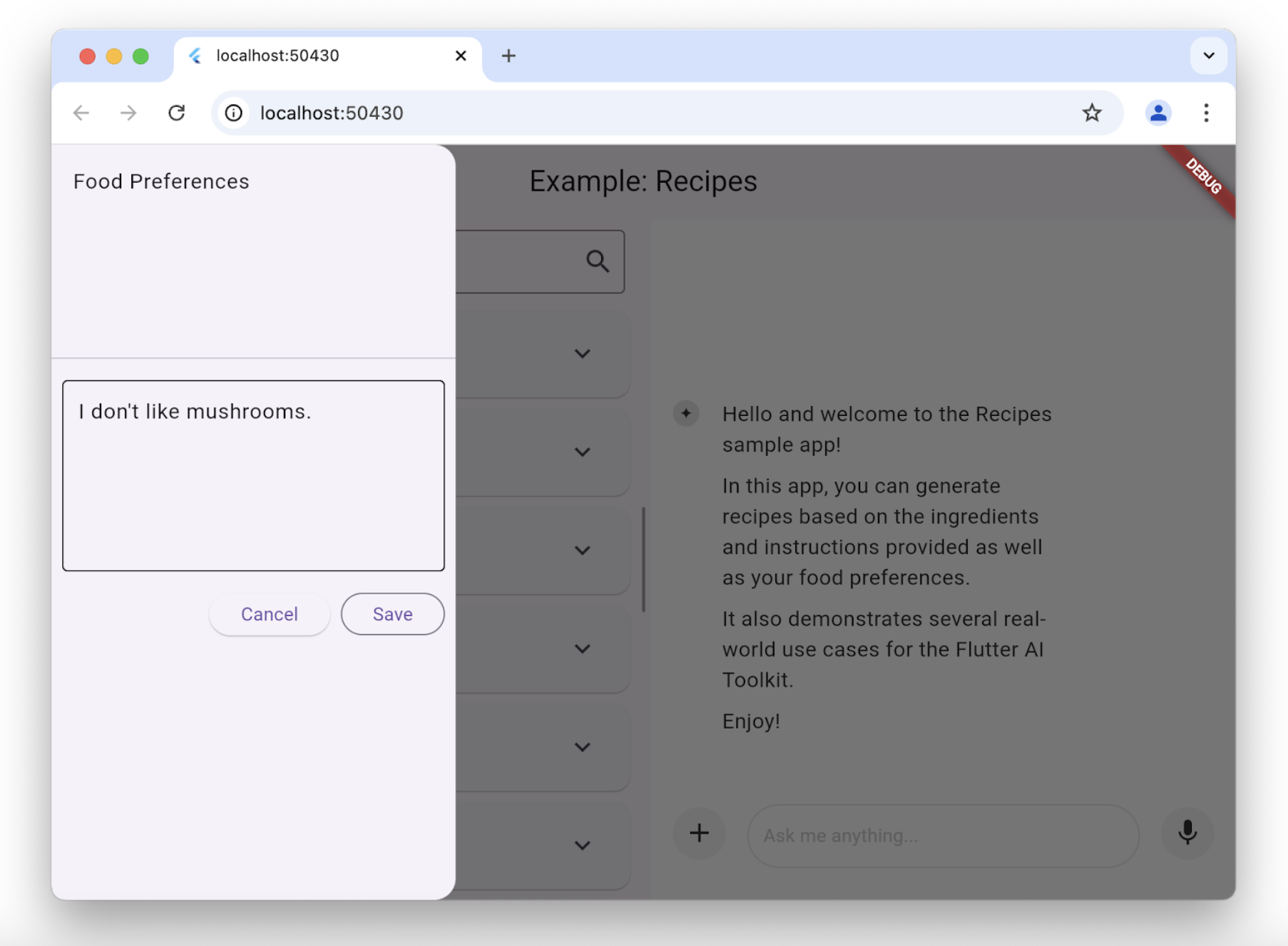
每當使用者變更飲食偏好時, 食譜應用程式就會建立一個新的模型,以使用新的偏好設定:
class _HomePageState extends State<HomePage> {
...
void _onSettingsSave() => setState(() {
// move the history over from the old provider to the new one
final history = _provider.history.toList();
_provider = _createProvider(history);
});
}停用附件與語音輸入
#如果你希望停用附件(+ 按鈕)或語音輸入(麥克風按鈕), 可以透過將 enableAttachments 和 enableVoiceNotes 參數 傳遞給 LlmChatView 建構子來達成:
class ChatPage extends StatelessWidget {
const ChatPage({super.key});
@override
Widget build(BuildContext context) {
// ...
return Scaffold(
appBar: AppBar(title: const Text('Restricted Chat')),
body: LlmChatView(
// ...
enableAttachments: false,
enableVoiceNotes: false,
),
);
}
}這兩個旗標的預設值都是true。
管理取消或錯誤行為
#預設情況下,當使用者取消大型語言模型 (LLM) 請求時,LLM 的回應會附加字串 "CANCEL",並且會跳出訊息提示使用者已取消該請求。同樣地,若發生 LLM 錯誤(例如網路連線中斷),LLM 的回應會附加字串 "ERROR",並且會跳出包含錯誤細節的警示對話框。
你可以透過LlmChatView的cancelMessage、errorMessage、onCancelCallback和onErrorCallback參數來覆寫預設的取消與錯誤行為。例如,下列程式碼會取代預設的取消處理行為:
class ChatPage extends StatelessWidget {
// ...
void _onCancel(BuildContext context) {
ScaffoldMessenger.of(
context,
).showSnackBar(const SnackBar(content: Text('Chat cancelled')));
}
@override
Widget build(BuildContext context) => Scaffold(
appBar: AppBar(title: const Text(App.title)),
body: LlmChatView(
// ...
onCancelCallback: _onCancel,
cancelMessage: 'Request cancelled',
),
);
}你可以覆寫這些參數中的任意一個或全部,LlmChatView 會對你未覆寫的部分使用其預設值。
管理歷史紀錄
#定義所有可插入聊天視圖的大型語言模型 (LLM) 提供者的標準介面 包含了取得與設定該提供者歷史紀錄的能力:
abstract class LlmProvider implements Listenable {
Stream<String> generateStream(
String prompt, {
Iterable<Attachment> attachments,
});
Stream<String> sendMessageStream(
String prompt, {
Iterable<Attachment> attachments,
});
Iterable<ChatMessage> get history;
set history(Iterable<ChatMessage> history);
}當 provider 的歷史紀錄發生變化時, 它會呼叫由 Listenable 基底類別所公開的 notifyListener 方法。這表示你可以手動 透過 add 和 remove 方法來訂閱/取消訂閱, 或用來建立 ListenableBuilder 類別的實例。
generateStream 方法會呼叫底層的大型語言模型 (LLM), 但不會影響歷史紀錄。而呼叫 sendMessageStream 方法時,當回應完成後,會在 provider 的歷史紀錄中新增兩則訊息—— 一則為使用者訊息,一則為 LLM 回應。聊天視圖在處理 使用者的聊天提示時會使用 sendMessageStream, 而在處理使用者語音輸入時則會使用 generateStream。
若要查看或設定歷史紀錄,你可以存取 history 屬性:
void _clearHistory() => _provider.history = [];當你需要在重新建立 provider 的同時保留歷史紀錄時,能夠存取 provider 的歷史紀錄也非常有用:
class _HomePageState extends State<HomePage> {
...
void _onSettingsSave() => setState(() {
// move the history over from the old provider to the new one
final history = _provider.history.toList();
_provider = _createProvider(history);
});
}_createProvider 方法會建立一個新的 provider,這個 provider 同時保留了前一個 provider 的歷史紀錄,以及新的使用者偏好設定。
對使用者來說,這個過程是無縫接軌的;他們可以繼續對話,而大型語言模型 (LLM) 現在會根據他們的新飲食偏好來回應。
例如:
class _HomePageState extends State<HomePage> {
...
// create a new provider with the given history and the current settings
LlmProvider _createProvider([List<ChatMessage>? history]) =>
GeminiProvider(
history: history,
...
);
...
}要實際體驗歷史紀錄功能, 請參考 recipes example app 以及 history example app。
聊天序列化/反序列化
#若要在應用程式的不同工作階段之間儲存與還原聊天歷史紀錄, 就需要能夠序列化與反序列化每一則使用者提示(包含附件)以及每一則大型語言模型 (LLM) 回應。這兩種類型的訊息 (使用者提示與 LLM 回應), 都會在 ChatMessage 類別中公開。 序列化可以透過每個 ChatMessage 實例的 toJson 方法來完成。
Future<void> _saveHistory() async {
// get the latest history
final history = _provider.history.toList();
// write the new messages
for (var i = 0; i != history.length; ++i) {
// skip if the file already exists
final file = await _messageFile(i);
if (file.existsSync()) continue;
// write the new message to disk
final map = history[i].toJson();
final json = JsonEncoder.withIndent(' ').convert(map);
await file.writeAsString(json);
}
}同樣地,若要進行反序列化,請使用 ChatMessage 類別的靜態 fromJson 方法:
Future<void> _loadHistory() async {
// read the history from disk
final history = <ChatMessage>[];
for (var i = 0;; ++i) {
final file = await _messageFile(i);
if (!file.existsSync()) break;
final map = jsonDecode(await file.readAsString());
history.add(ChatMessage.fromJson(map));
}
// set the history on the controller
_provider.history = history;
}為了確保序列化時能夠快速回應, 我們建議每則使用者訊息只寫入一次。 否則,使用者必須等待您的應用程式 每次都將所有訊息寫入, 遇到二進位附件時, 這個過程可能會花費較長時間。
若想實際了解這個做法,請參考 history example app。
自訂回應元件 (Custom response widgets)
#預設情況下,聊天視圖所顯示的 大型語言模型 (LLM) 回應會以 Markdown 格式呈現。然而,在某些情境下, 您可能希望建立自訂元件 (Widget), 以顯示與您的應用程式高度整合、專屬於該應用程式的 LLM 回應。例如,當使用者在 recipes example app 中請求食譜時, LLM 回應會被用來建立一個專門顯示食譜的元件, 這個元件的呈現方式與應用程式其他部分一致, 並且提供一個 新增 按鈕,讓使用者可以將 食譜加入他們的資料庫:
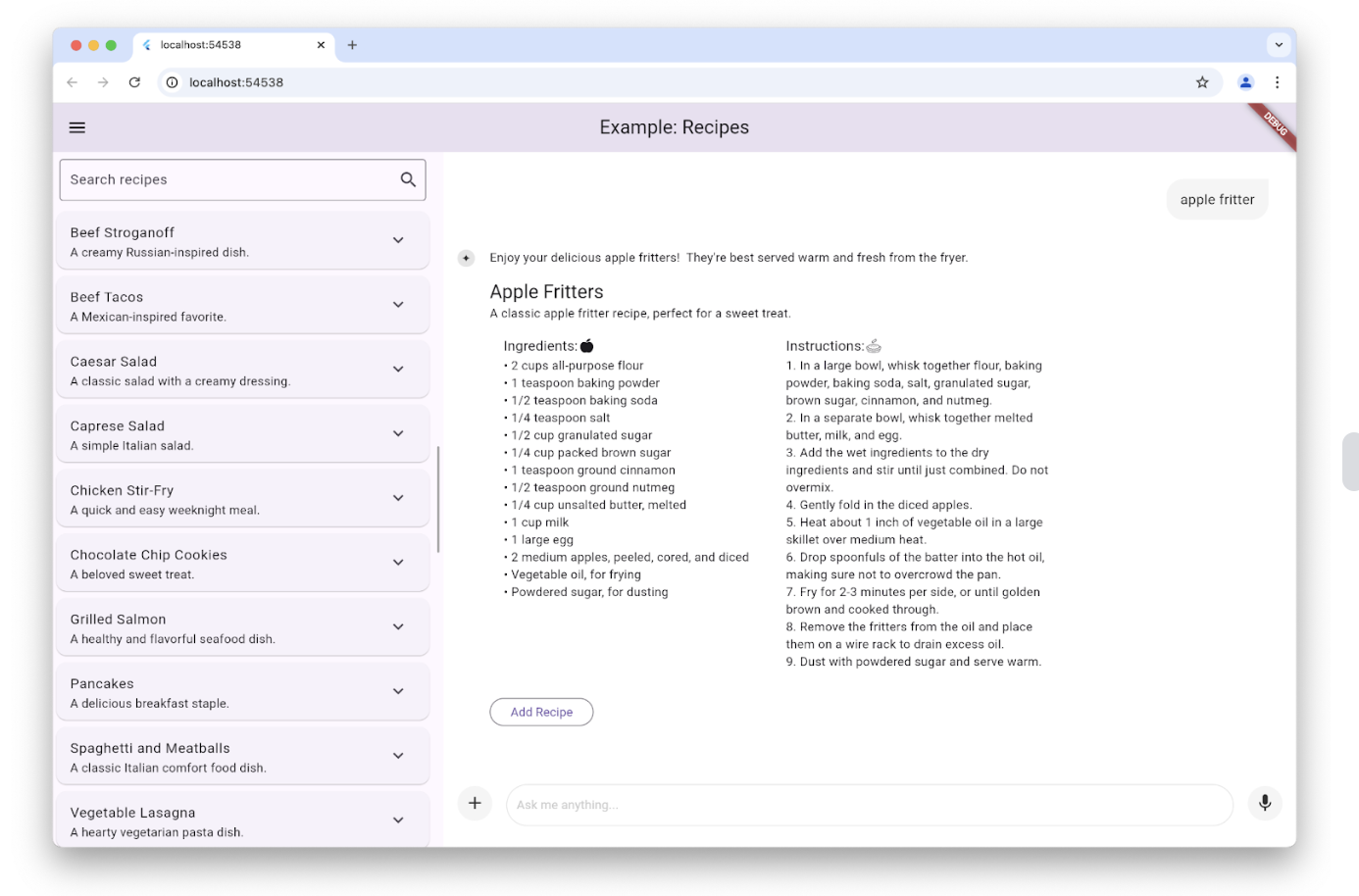
這是透過在 LlmChatView 建構函式中設定 responseBuilder 參數來實現的:
LlmChatView(
provider: _provider,
welcomeMessage: _welcomeMessage,
responseBuilder: (context, response) => RecipeResponseView(
response,
),
),在這個特定範例中,RecipeReponseView 元件(Widget)是以大型語言模型 (LLM) 服務提供者的回應文字來建構, 並利用該文字來實作其 build 方法:
class RecipeResponseView extends StatelessWidget {
const RecipeResponseView(this.response, {super.key});
final String response;
@override
Widget build(BuildContext context) {
final children = <Widget>[];
String? finalText;
// created with the response from the LLM as the response streams in, so
// many not be a complete response yet
try {
final map = jsonDecode(response);
final recipesWithText = map['recipes'] as List<dynamic>;
finalText = map['text'] as String?;
for (final recipeWithText in recipesWithText) {
// extract the text before the recipe
final text = recipeWithText['text'] as String?;
if (text != null && text.isNotEmpty) {
children.add(MarkdownBody(data: text));
}
// extract the recipe
final json = recipeWithText['recipe'] as Map<String, dynamic>;
final recipe = Recipe.fromJson(json);
children.add(const Gap(16));
children.add(Column(
crossAxisAlignment: CrossAxisAlignment.start,
children: [
Text(recipe.title, style: Theme.of(context).textTheme.titleLarge),
Text(recipe.description),
RecipeContentView(recipe: recipe),
],
));
// add a button to add the recipe to the list
children.add(const Gap(16));
children.add(OutlinedButton(
onPressed: () => RecipeRepository.addNewRecipe(recipe),
child: const Text('Add Recipe'),
));
children.add(const Gap(16));
}
} catch (e) {
debugPrint('Error parsing response: $e');
}
...
return Column(
crossAxisAlignment: CrossAxisAlignment.start,
children: children,
);
}
}這段程式碼會解析文字,從大型語言模型(LLM)中擷取前言文字與食譜,並將它們與一個 Add Recipe 按鈕一起組合,顯示在原本 Markdown 的位置。
請注意,我們將 LLM 的回應解析為 JSON。 通常會將提供者設為 JSON 模式,並提供一個 schema(結構定義),以限制其回應格式,確保我們能夠正確解析。 每個提供者都以自己的方式提供這項功能, 但 GeminiProvider 和 VertexProvider 這兩個類別 都能透過 GenerationConfig 物件來實現, 而食譜範例則如下使用:
class _HomePageState extends State<HomePage> {
...
// create a new provider with the given history and the current settings
LlmProvider _createProvider([List<ChatMessage>? history]) => GeminiProvider(
...
model: GenerativeModel(
...
generationConfig: GenerationConfig(
responseMimeType: 'application/json',
responseSchema: Schema(...),
systemInstruction: Content.system('''
...
Generate each response in JSON format
with the following schema, including one or more "text" and "recipe" pairs as
well as any trailing text commentary you care to provide:
{
"recipes": [
{
"text": "Any commentary you care to provide about the recipe.",
"recipe":
{
"title": "Recipe Title",
"description": "Recipe Description",
"ingredients": ["Ingredient 1", "Ingredient 2", "Ingredient 3"],
"instructions": ["Instruction 1", "Instruction 2", "Instruction 3"]
}
}
],
"text": "any final commentary you care to provide",
}
''',
),
),
);
...
}這段程式碼會初始化 GenerationConfig 物件, 將 responseMimeType 參數設為 'application/json', 並將 responseSchema 參數設為 Schema 類別的實例, 該類別定義了你準備解析的 JSON 結構。此外, 建議在系統指令中同時要求回傳 JSON,並提供該 JSON schema 的描述——這裡我們已經這麼做了。
想要實際體驗,請參考 recipes example app。
自訂樣式
#聊天視圖(chat view)預設提供了一套背景、文字欄位(text field)、按鈕、圖示、建議等的預設樣式。 你可以透過在 LlmChatView 建構函式中設定 style 參數,完全自訂這些樣式:
LlmChatView(
provider: GeminiProvider(...),
style: LlmChatViewStyle(...),
),例如,custom styles example app 就利用這個功能實作了一個具有萬聖節主題的應用程式:
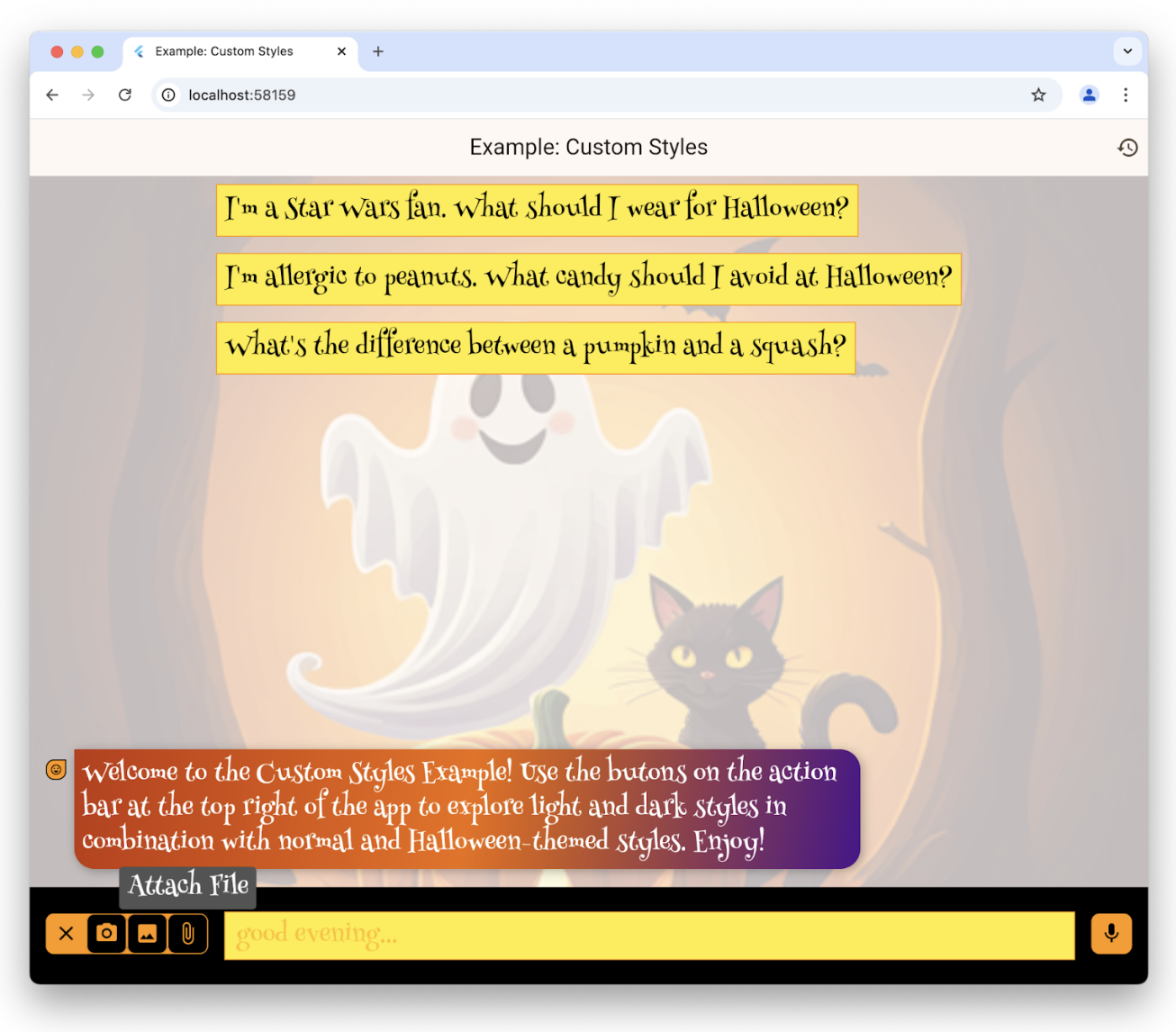
如需LlmChatViewStyle類別中可用樣式的完整清單,請參閱reference documentation。 若想實際了解自訂樣式的運作方式, 除了可以參考custom styles example之外, 也建議查看dark mode example以及demo app。
無 UI 的聊天功能
#你不一定要使用聊天視圖(chat view)來存取底層提供者的功能。 除了可以直接透過其專屬介面呼叫之外, 你也可以搭配LlmProvider interface來使用。
舉例來說,recipes 範例應用程式在頁面上提供了一個 Magic 按鈕來編輯食譜。 這個按鈕的目的是根據你目前的飲食偏好, 更新資料庫中的現有食譜。 按下按鈕後,你可以預覽推薦的變更內容, 並決定是否要套用這些變更:
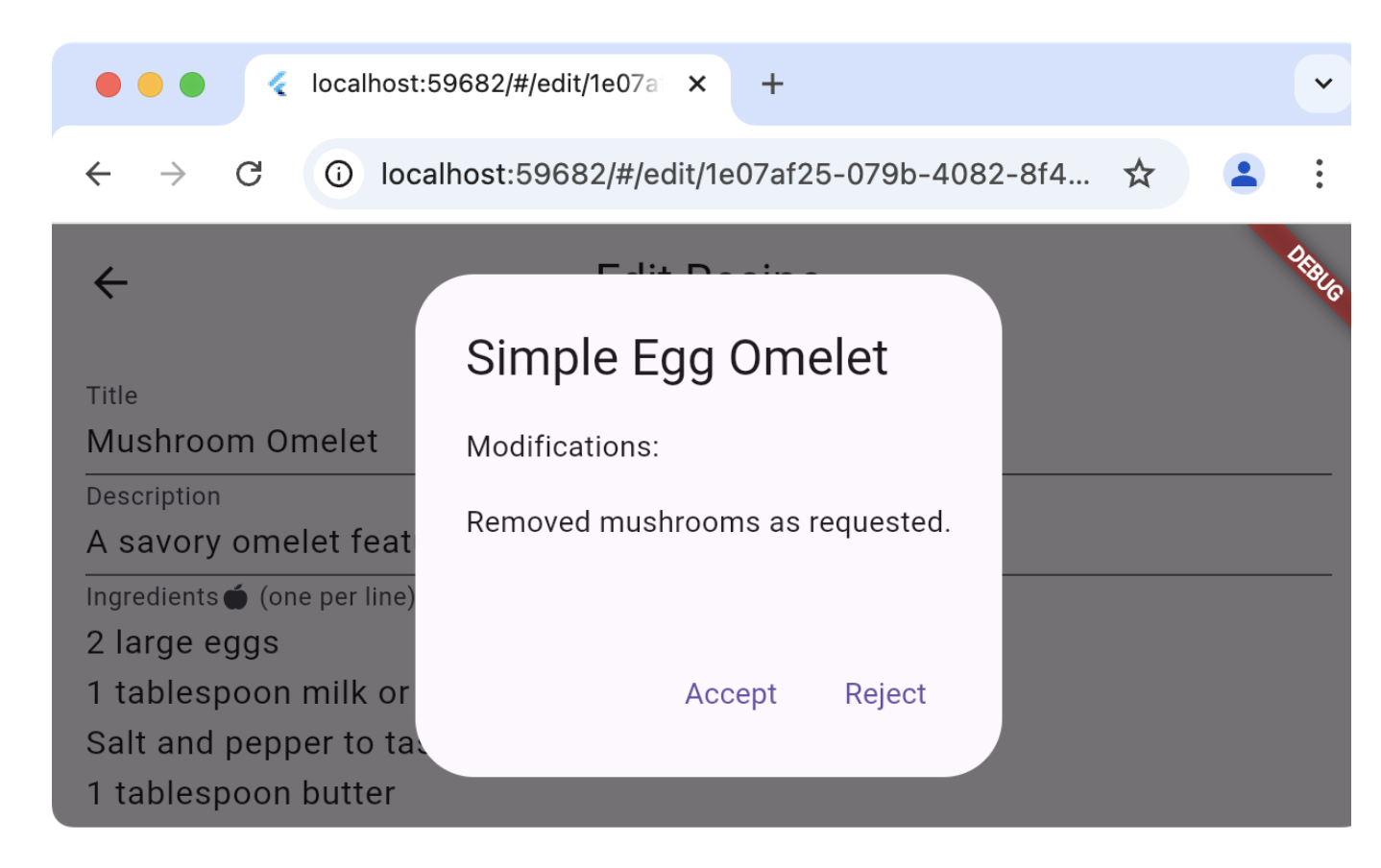
與其使用應用程式聊天區塊所用的同一個提供者(provider), 這樣會將多餘的使用者訊息與大型語言模型 (LLM) 回應插入使用者的聊天紀錄, Edit Recipe 頁面反而會自行建立一個提供者, 並直接加以使用:
class _EditRecipePageState extends State<EditRecipePage> {
...
final _provider = GeminiProvider(...);
...
Future<void> _onMagic() async {
final stream = _provider.sendMessageStream(
'Generate a modified version of this recipe based on my food preferences: '
'${_ingredientsController.text}\n\n${_instructionsController.text}',
);
var response = await stream.join();
final json = jsonDecode(response);
try {
final modifications = json['modifications'];
final recipe = Recipe.fromJson(json['recipe']);
if (!context.mounted) return;
final accept = await showDialog<bool>(
context: context,
builder: (context) => AlertDialog(
title: Text(recipe.title),
content: Column(
crossAxisAlignment: CrossAxisAlignment.start,
children: [
const Text('Modifications:'),
const Gap(16),
Text(_wrapText(modifications)),
],
),
actions: [
TextButton(
onPressed: () => context.pop(true),
child: const Text('Accept'),
),
TextButton(
onPressed: () => context.pop(false),
child: const Text('Reject'),
),
],
),
);
...
} catch (ex) {
...
}
}
}
}對 sendMessageStream 的呼叫會在提供者(provider)的歷史紀錄中建立條目,但由於這些條目沒有關聯到聊天視圖(chat view),因此不會顯示出來。如果方便的話,你也可以透過呼叫 generateStream 來達到相同的效果,這樣可以重複使用現有的 provider,同時不會影響聊天歷史紀錄。
想要實際了解這個流程,可以參考 recipes 範例的 Edit Recipe page。
重新導向提示(Rerouting prompts)
#如果你希望除錯、記錄或操作聊天視圖(chat view)與底層 provider 之間的連線,可以實作一個 LlmStreamGenerator 函式來達成。然後,將該函式傳遞給 LlmChatView 的 messageSender 參數:
class ChatPage extends StatelessWidget {
final _provider = GeminiProvider(...);
@override
Widget build(BuildContext context) => Scaffold(
appBar: AppBar(title: const Text(App.title)),
body: LlmChatView(
provider: _provider,
messageSender: _logMessage,
),
);
Stream<String> _logMessage(
String prompt, {
required Iterable<Attachment> attachments,
}) async* {
// log the message and attachments
debugPrint('# Sending Message');
debugPrint('## Prompt\n$prompt');
debugPrint('## Attachments\n${attachments.map((a) => a.toString())}');
// forward the message on to the provider
final response = _provider.sendMessageStream(
prompt,
attachments: attachments,
);
// log the response
final text = await response.join();
debugPrint('## Response\n$text');
// return it
yield text;
}
}此範例會在用戶與大型語言模型 (LLM) 之間來回互動時,記錄用戶的提示與 LLM 的回應。當你將函式作為messageSender提供時,你需要自行負責呼叫底層的服務提供者。如果你沒有這麼做,服務提供者將無法收到訊息。這項能力讓你可以實現進階功能,例如動態路由至不同的服務提供者,或進行檢索增強生成(Retrieval Augmented Generation, RAG)。
想要實際體驗,請參考 logging example app。